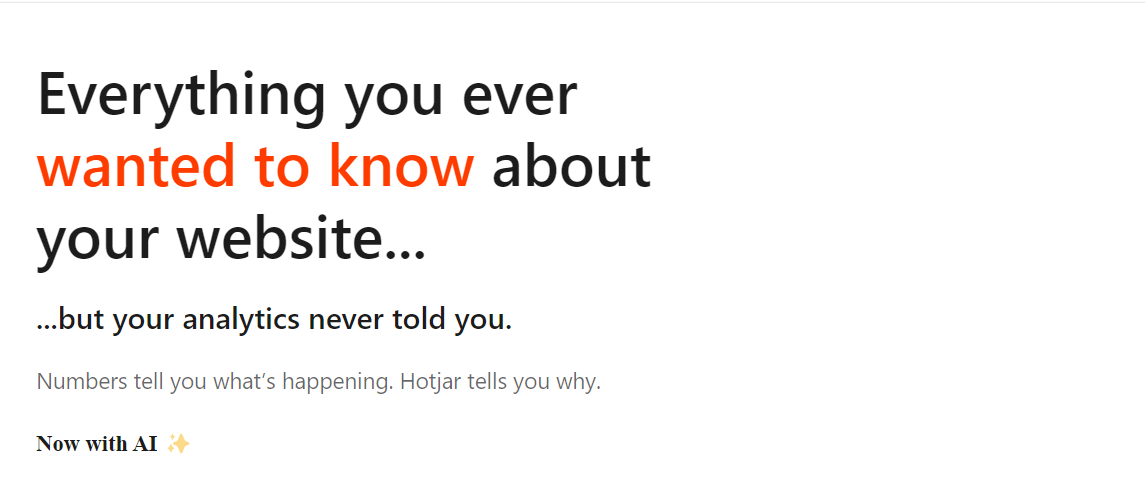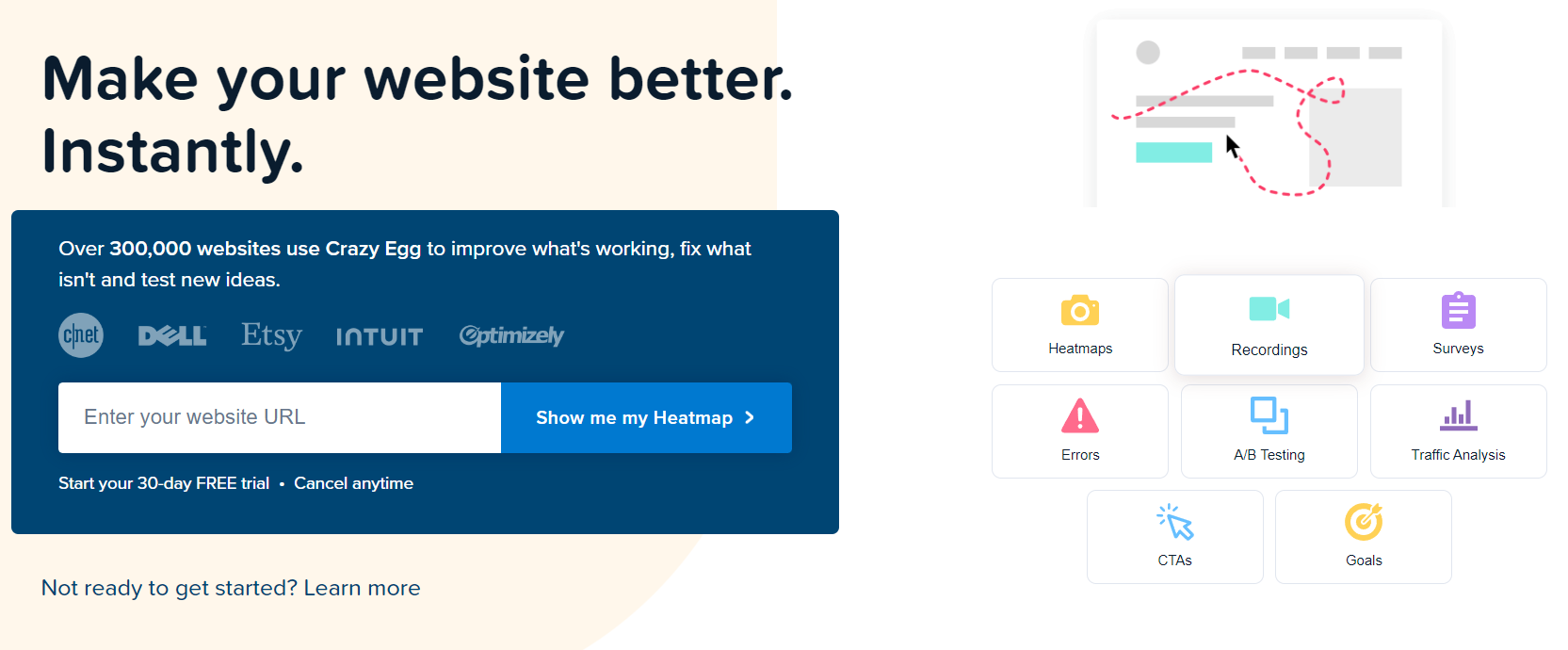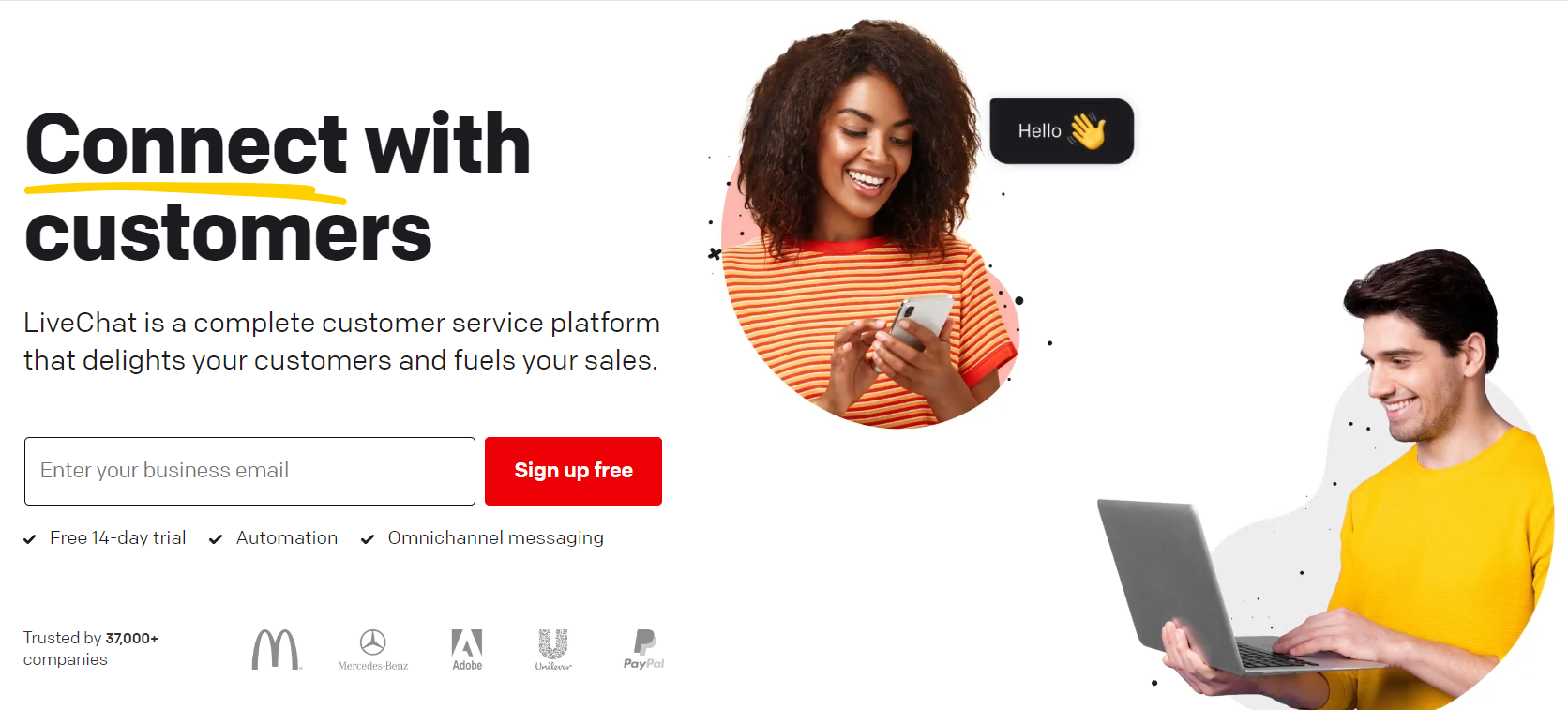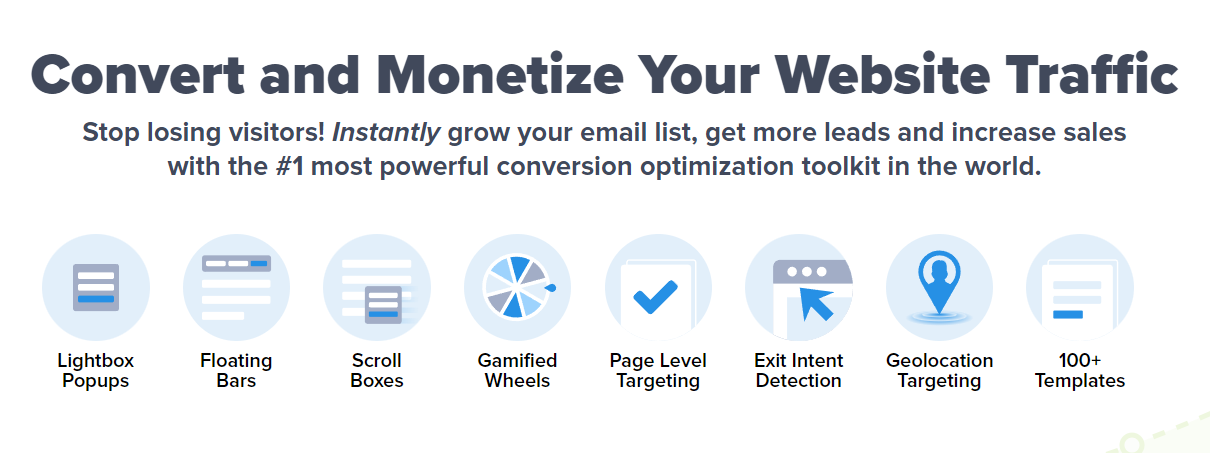How CRO Tools can Increase your Website Conversions

Your website is a valuable asset, but it's only worth anything if it's converting visitors into customers. That's where conversion rate optimization (CRO) comes in. CRO is the process of improving your website to make it more likely that visitors will take the desired action, such as signing up for your email list, making a purchase, or filling out a contact form.
CRO research tools can be a big help in this process. They can help you understand how visitors are interacting with your website, identify areas for improvement, and test different changes to see what works best.
In this blog post, we'll show you how to use Conversion rate optimization tools to increase your website conversions. We'll cover everything from choosing the right e-commerce tools to setting up your first A/B test.
What are CRO tools?
CRO stands for Conversion Rate Optimization. It's a process of improving a website or a digital platform to increase the percentage of visitors who take a desired action, such as making a purchase, signing up for a newsletter, or filling out a contact form. Conversion Rate Optimisation tools are software or platforms that assist in optimizing and improving the conversion rate.
These tools help businesses analyze user behavior, conduct experiments, and make data-driven decisions to enhance the effectiveness of their digital presence
Types of CRO tools
CRO monitoring tools generally fall into four categories:
Web Analytics CRO Tools
Meaning: These tools focus on gathering and analyzing data related to website traffic, user behavior, and other key performance indicators (KPIs).
Purpose: They provide insights into how users interact with a website, helping businesses understand what works and what doesn't.
Behavior Analytics CRO Tools
Meaning: These tools delve deeper into user behavior, often utilizing heatmaps, session recordings, and other techniques to visualize how visitors navigate and engage with a website.
Purpose: They offer detailed, visual representations of user interactions, enabling businesses to identify areas for improvement.
CRO Testing Tools
Meaning: These tools facilitate the process of conducting experiments, such as A/B tests, to compare different versions of a webpage or element and determine which one leads to higher conversions.
Purpose: They help businesses make data-driven decisions about design, content, and layout changes.
Lead Capture Tools
Meaning: These tools focus on capturing visitor information, such as email addresses or contact details, often through forms or pop-ups.
Purpose: They assist in building a database of potential customers or leads for future marketing efforts.
How CRO tools works?
Here's a breakdown of how CRO research tools work in five segments:
Data Collection and Analysis
CRO tools start by gathering data on user behavior, such as clicks, page views, and interactions. They then analyze this data to identify trends and patterns in user engagement.
User Experience Optimization
These tools focus on improving the overall user experience by providing insights into how visitors navigate a website. For instance, behavior analytics tools like heatmaps and session recordings visualize user interactions, helping to identify areas for enhancement.
Experimentation and Testing
CRO testing tools enable businesses to conduct experiments, like A/B tests, to compare different versions of a webpage or element. This helps in determining which version leads to higher conversions.
Hypothesis Formulation and Implementation
CRO practitioners use data-driven insights to create hypotheses about what changes could lead to improved conversions. These hypotheses guide the implementation of changes, which may involve altering content, layout, design elements, or other aspects of the user experience.
Monitoring and Iteration
After changes are applied, CRO tools continue to monitor user behavior and assess the impact of the alterations. They provide reports and insights that inform further optimization efforts, creating an iterative process of continuous improvement. This may involve making additional adjustments and conducting new experiments based on the results.
Why is CRO important?
Here are the top 5 reasons why Conversion Rate Optimization (CRO) is important:
Maximizes Return on Investment (ROI)
CRO helps businesses get more value from their existing traffic and marketing efforts. By increasing the percentage of visitors who take a desired action, businesses can improve their ROI without necessarily increasing their advertising budget.
Enhances User Experience
CRO involves understanding user behavior and preferences, leading to improvements in website design, content, and functionality. This results in a better user experience, which can lead to increased trust, satisfaction, and loyalty among visitors.
Boosts Revenue and Profits
Higher conversion rates mean more visitors are converting into customers or taking other desired actions, such as signing up for a newsletter or requesting more information. This directly translates to increased revenue and profits for the business.
Reduces Customer Acquisition Costs
Acquiring new customers can be expensive. By improving conversion rates, businesses can make the most of their current traffic without having to invest additional resources in attracting new visitors. This can lead to significant cost savings over time.
Provides Data-Driven Insights
CRO involves data collection, analysis, and experimentation. This provides businesses with valuable insights into user behavior, preferences, and what elements of their website are most effective. These insights can inform future marketing and optimization efforts.
How can CRO tools help you increase your website conversions?
CRO tools play a crucial role in increasing website conversions by providing valuable data, enabling experimentation, and facilitating data-driven decision-making. Here's CRO framework can help:
User Behavior Analysis
CRO tools like heatmaps and session recordings allow you to visually analyze how users interact with your website. This helps identify areas of interest, popular content, and potential pain points. By understanding user behavior, you can make informed decisions to optimize the user experience.
A/B Testing
CRO testing tools enable you to conduct experiments, such as A/B tests, to compare different versions of a webpage or element. This helps determine which version leads to higher conversions. Through A/B testing, you can systematically refine elements of your website for improved performance.
Multivariate Testing
Some CRO tools allow for more complex experiments involving multiple variations of elements on a webpage. This helps you understand how different combinations of changes impact conversions. It's particularly useful for testing interactions between multiple elements.
Surveys and Feedback
CRO tools can integrate surveys and feedback forms directly on your website. This allows you to gather qualitative data from users about their preferences, pain points, and suggestions for improvement. This information is invaluable for making targeted optimizations.
Segmentation and Personalization
Some CRO tools enable you to segment your audience based on various criteria like demographics, behavior, or location. This allows you to deliver personalized content or offers to specific user groups, increasing the likelihood of conversion.
Real-time Data Monitoring
CRO tools provide real-time data on user interactions, conversions, and other relevant metrics. This allows you to monitor the performance of your website and make adjustments promptly based on live data.
User Testing and Feedback
Some CRO monitoring tools facilitate user testing sessions, where real users interact with your website and provide feedback. This gives you direct insights into how users experience your site, allowing you to make targeted improvements.
Identifying Conversion Barriers
CRO tools can help identify potential obstacles that may be hindering conversions. This could be anything from confusing navigation to poorly designed forms. By pinpointing these issues, you can take steps to remove or mitigate them.
Data-driven Decision-making
CRO tools provide objective data that helps you make informed decisions about design, content, and functionality changes. This reduces reliance on guesswork and intuition, leading to more effective optimization strategies.
Iterative Improvement
CRO tools support an iterative process of continuous improvement. After implementing changes based on test results, you can continue to test and refine, gradually increasing your conversion rates over time.
What factors to consider when choosing CRO tools?
Choosing the right Conversion Rate Optimization (CRO) tools is crucial for effectively optimizing your website for conversions. Here are key factors to consider when making your selection:
Ease of Use
The tool should be user-friendly and intuitive. It should have a clear interface and easy navigation to ensure that you and your team can use it efficiently.
Integration Capabilities
Consider whether the CRO tool integrates with your existing tech stack. It should be compatible with your website platform, analytics tools, and other software you use.
Testing Capabilities
Look for A/B testing, multivariate testing, and other experiment capabilities. The tool should allow you to conduct a range of tests to identify what works best for your audience.
Data Collection and Analysis
The tool should offer robust data collection and analysis features. This includes tracking user behavior, providing detailed reports, and offering insights that guide optimization efforts.
Segmentation and Personalization
The tool should enable you to segment your audience based on various criteria, allowing for personalized experiences. This is essential for targeting specific user groups with tailored content or offers.
User Feedback and Surveys
Look for tools that facilitate the collection of user feedback through surveys, polls, or feedback forms. This qualitative data can provide valuable insights into user preferences and pain points.
Heatmaps and Session Recordings
These features visually represent user interactions on your website. Heatmaps show where users click, scroll, and spend their time, while session recordings allow you to watch how users navigate your site in real-time.
Cost and ROI
Consider the pricing structure of the CRO tool and assess whether the features provided justify the cost. Calculate the potential return on investment (ROI) based on expected improvements in conversion rates.
Customer Support and Training
Evaluate the level of customer support provided by the tool's vendor. Look for resources like documentation, tutorials, and responsive customer service teams to assist you when needed.
Case Studies and Reviews
Research the tool's reputation by reading case studies and customer reviews. This can provide valuable insights into the tool's effectiveness and how other businesses have benefited from using it.
Security and Compliance
Ensure that the conversion optimization plalform complies with industry standards and regulations, particularly if your business operates in a highly regulated industry like healthcare or finance.
Scalability
Consider whether the CRO tool can scale with your business. It should be able to handle increased traffic and testing complexity as your website and audience grow.
Trial Period or Demo
Many CRO tools offer trial periods or demos. Take advantage of these opportunities to test the tool's functionality and see if it meets your specific needs.
Best conversion rate optimization tools
Here is a list of 10 popular & some of free CRO tools, along with a brief explanation of what they do:
Manifest AI

Manifest AI is a GPT powered AI tool especially for Shopify stores. This is a powerful CRO tool that can help in boosting conversions with seamless product discovery, personalized product recommendations, and more.
BIK

BIK is a conversational AI tool and one of the best cro tools that helps businesses optimize their conversations with customers to increase conversion rates. It boosts customer conversions with Instagram automation, CRM and gamification.
Optimizely

Optimizely is a paid CRO tool that offers a wider range of features than Google Optimize, including multivariate testing and personalization. It's a good choice for businesses that need more advanced CRO capabilities.
VWO

VWO is another paid and best CRO tool that offers a wide range of features, including A/B testing, multivariate testing, and personalization. It's a good choice for businesses of all sizes.
Hotjar

Hotjar is a CRO tool that focuses on user behavior analytics. It allows you to see how visitors are interacting with your website through heatmaps, session recordings, and surveys. This information can help you identify areas for improvement and make changes to your website that will increase conversions.
Crazy Egg

Crazy Egg is another CRO tool that focuses on user behavior analytics. It offers similar features to Hotjar, such as heatmaps and session recordings.
FullStory

FullStory is a CRO tool that offers a complete digital experience platform. It allows you to see how visitors are interacting with your website, mobile app, and other digital products. This information can help you identify areas for improvement and make changes that will improve the user experience and increase conversions.
Heap

Heap is a CRO tool that helps you track user behavior and product analytics. It allows you to see how visitors are interacting with your website and how they're using your products. This information can help you improve the user experience and increase conversions.
Mixpanel

Mixpanel is a CRO tool that helps you track user behavior and product analytics. It's similar to Heap, but it offers a more focused set of features.
LiveChat

LiveChat is a CRO tool that allows you to chat with visitors in real time. This can help you answer their questions, resolve their issues, and guide them towards taking the desired action.
OptinMonster

OptinMonster is a CRO tool that helps you create and manage opt-in forms. You can use OptinMonster to create popups, slide-ins, and other types of opt-in forms that will help you collect email addresses and other leads.
These are the best CRO tools list that help you achieve your specific goals. For example, if you're trying to increase your website's conversion rate, you might want to use a tool like Google Optimize or Optimizely to run A/B tests. If you're trying to improve the user experience of your website, you might want to use a tool like Hotjar or Crazy Egg to track user behavior.
Final thoughts
Conversion rate optimization (CRO) is the process of improving your website to make it more likely that visitors will take the desired action, such as signing up for your email list, making a purchase, or filling out a contact form.
CRO tools can be a big help in this process. They can help you understand how visitors are interacting with your website, identify areas for improvement, and test different changes to see what works best.
Frequently asked questions
Here are the most frequently asked questions related to CRO tools:
What is A/B testing?
A/B testing is a method of comparing two versions of a webpage or app screen to determine which one performs better. This is done by randomly assigning visitors to one of the two versions and then comparing the results, such as click-through rate, conversion rate, or time spent on page.
How to choose the right A/B testing tool?
There are a number of factors to consider when choosing an A/B testing tool, such as:
Features: What features are important to you? Do you need a tool that offers A/B testing, multivariate testing, and personalization? Or is A/B testing all you need?
Ease of use: How easy is the tool to use? Are you able to set up and run A/B tests without any coding knowledge?
Price: How much does the tool cost? Are there any free or freemium plans available?
How to run A/B TEST?
Once you've chosen an A/B testing tool, you can start running A/B tests. Here are the basic steps:
Identify the element you want to test. What element of your webpage or app screen do you want to test? Could be a headline, image, call to action, or anything else.
Create two versions of the element. Create two different versions of the element you want to test. Make sure the only difference between the two versions is the element you're testing.
Set up your A/B test. Use your A/B testing tool to set up an A/B test. This will involve specifying the two versions of the element you want to test, as well as the percentage of visitors you want to assign to each version.
Run your A/B test. Once you've set up your A/B test, you can start running it. Your A/B testing tool will randomly assign visitors to one of the two versions of the element you're testing.
Analyze your results. Once your A/B test has run for a sufficient period of time, you can analyze the results. This will involve comparing the performance of the two versions of the element you tested.

.png)
